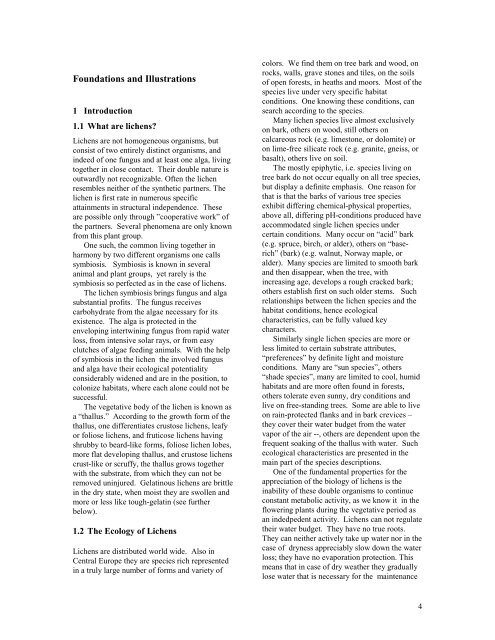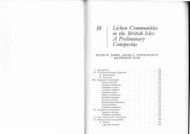Create successful ePaper yourself
Turn your PDF publications into a flip-book with our unique Google optimized e-Paper software.
Foundations and Illustrations<br />
1 Introduction<br />
1.1 What are lichens?<br />
<strong>Lichens</strong> are not homogeneous organisms, but<br />
consist <strong>of</strong> two entirely distinct organisms, and<br />
indeed <strong>of</strong> one fungus and at least one alga, living<br />
together in close contact. Their double nature is<br />
outwardly not recognizable. Often the lichen<br />
resembles neither <strong>of</strong> the synthetic partners. The<br />
lichen is first rate in numerous specific<br />
attainments in structural independence. These<br />
are possible only through ”cooperative work” <strong>of</strong><br />
the partners. Several phenomena are only known<br />
from this plant group.<br />
One such, the common living together in<br />
harmony by two different organisms one calls<br />
symbiosis. Symbiosis is known in several<br />
animal and plant groups, yet rarely is the<br />
symbiosis so perfected as in the case <strong>of</strong> lichens.<br />
The lichen symbiosis brings fungus and alga<br />
substantial pr<strong>of</strong>its. The fungus receives<br />
carbohydrate from the algae necessary for its<br />
existence. The alga is protected in the<br />
enveloping intertwining fungus from rapid water<br />
loss, from intensive solar rays, or from easy<br />
clutches <strong>of</strong> algae feeding animals. With the help<br />
<strong>of</strong> symbiosis in the lichen the involved fungus<br />
and alga have their ecological potentiality<br />
considerably widened and are in the position, to<br />
colonize habitats, where each alone could not be<br />
successful.<br />
The vegetative body <strong>of</strong> the lichen is known as<br />
a “thallus.” According to the growth form <strong>of</strong> the<br />
thallus, one differentiates crustose lichens, leafy<br />
or foliose lichens, and fruticose lichens having<br />
shrubby to beard-like forms, foliose lichen lobes,<br />
more flat developing thallus, and crustose lichens<br />
crust-like or scruffy, the thallus grows together<br />
with the substrate, from which they can not be<br />
removed uninjured. Gelatinous lichens are brittle<br />
in the dry state, when moist they are swollen and<br />
more or less like tough-gelatin (see further<br />
below).<br />
1.2 The Ecology <strong>of</strong> <strong>Lichens</strong><br />
<strong>Lichens</strong> are distributed world wide. Also in<br />
Central Europe they are species rich represented<br />
in a truly large number <strong>of</strong> forms and variety <strong>of</strong><br />
colors. We find them on tree bark and wood, on<br />
rocks, walls, grave stones and tiles, on the soils<br />
<strong>of</strong> open forests, in heaths and moors. Most <strong>of</strong> the<br />
species live under very specific habitat<br />
conditions. One knowing these conditions, can<br />
search according to the species.<br />
Many lichen species live almost exclusively<br />
on bark, others on wood, still others on<br />
calcareous rock (e.g. limestone, or dolomite) or<br />
on lime-free silicate rock (e.g. granite, gneiss, or<br />
basalt), others live on soil.<br />
The mostly epiphytic, i.e. species living on<br />
tree bark do not occur equally on all tree species,<br />
but display a definite emphasis. One reason for<br />
that is that the barks <strong>of</strong> various tree species<br />
exhibit differing chemical-physical properties,<br />
above all, differing pH-conditions produced have<br />
accommodated single lichen species under<br />
certain conditions. Many occur on “acid” bark<br />
(e.g. spruce, birch, or alder), others on “base-<br />
rich” (bark) (e.g. walnut, Norway maple, or<br />
alder). Many species are limited to smooth bark<br />
and then disappear, when the tree, with<br />
increasing age, develops a rough cracked bark;<br />
others establish first on such older stems. Such<br />
relationships between the lichen species and the<br />
habitat conditions, hence ecological<br />
characteristics, can be fully valued key<br />
characters.<br />
Similarly single lichen species are more or<br />
less limited to certain substrate attributes,<br />
“preferences” by definite light and moisture<br />
conditions. Many are “sun species”, others<br />
“shade species”, many are limited to cool, humid<br />
habitats and are more <strong>of</strong>ten found in forests,<br />
others tolerate even sunny, dry conditions and<br />
live on free-standing trees. Some are able to live<br />
on rain-protected flanks and in bark crevices –<br />
they cover their water budget from the water<br />
vapor <strong>of</strong> the air --, others are dependent upon the<br />
frequent soaking <strong>of</strong> the thallus with water. Such<br />
ecological characteristics are presented in the<br />
main part <strong>of</strong> the species descriptions.<br />
One <strong>of</strong> the fundamental properties for the<br />
appreciation <strong>of</strong> the biology <strong>of</strong> lichens is the<br />
inability <strong>of</strong> these double organisms to continue<br />
constant metabolic activity, as we know it in the<br />
flowering plants during the vegetative period as<br />
an indedpedent activity. <strong>Lichens</strong> can not regulate<br />
their water budget. They have no true roots.<br />
They can neither actively take up water nor in the<br />
case <strong>of</strong> dryness appreciably slow down the water<br />
loss; they have no evaporation protection. This<br />
means that in case <strong>of</strong> dry weather they gradually<br />
lose water that is necessary for the maintenance<br />
4





